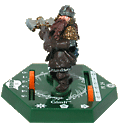
I got the word in December of 2002 that not only was I going to be designing a The Lord of the Rings™
miniatures game, but that I would be flying to England (home of a small game company called Games Workshop)
to consult with Rick Priestly on the design! If you don't know who Rick is, he's
basically the father of modern fantasy tabletop wargaming. If you've ever played a game where you had to
roll to hit, roll to wound, then roll a save, you probably have him to thank.
It turns out that despite reports of him being an "ogre", he's actually a great guy! (It turns
out that those reports were given to me by someone who thought I was talking about Rick Moranis) He was a font
of truly sage advice on all things wargaming, and I knocked on his door many, many times during the week I spent
at the cavernous offices of GW.
I decided on the long flight to England that I wanted the game to be about Heroes leading minions
in skirmish-style battles. That way, the game could focus on the cool heroes of the movies but could
still use all the varied troop types seen in the battles. This concept also works well for a collectible miniatures
game, as it doesn't require a huge purchase on the part of the players.
Bringing out the flavor of Middle Earth™ in a collectible miniatures game was the big challenge. How do you
make a game "feel" like The Lord of the Rings™?

The key was special abilities. I made the basics of the game fairly straightforward, and brought
the feel of the world out in the abilities. Most of them were inspired by scenes straight out of the movies, while
the rest were natural extensions of the character's abilities. Let's look at a few:
Arrow Flurry: That scene in The Fellowship of the Ring where Legolas is pulling arrows out of
his quiver, firing them, and reloading in quick succession was one of the coolest effects in the movie. It inspired
the arrow flurry ability, which doubles the number of shots the model can fire, and lets him damage any model he can
see.
Courage: When Boromir fights on in the battle of Amon Hen after having several arrows in his chest,
I knew that had to be an ability. Normally, models that are reduced to zero wounds are removed from play. Warriors with
the courage ability aren't removed until the end of the next turn.
Magical Force: This ability, which lets the user move enemy models, was inspired by the battle
between Gandalf and Saruman in the Tower of Orthanc.
Dread: I really liked the scene in Fellowship when the Ringwraiths were looking for Frodo and
company, and almost found them while they were hiding in the tangled roots of a tree. The Ringwraith is very close,
sniffing the air it seems, and Frodo notices all manner of bugs and worms creeping out of the ground because of the
presence of the Nazgul. This gave me the idea for the Dread ability, which makes enemy models pay more action points
while they are in an adjacent hex.

The One Ring™: Of course, no The Lord of the Rings™ game would be complete without including
the One Ring™. If you include Frodo in your army, you can use the Ring. The first idea I
had for this was to use a special base to represent Frodo wearing the Ring - a base with no figure. This represents
the fact that he is invisible perfectly. It is included in the starter sets so that you don't have to worry
about getting one in a booster.
When it is your turn, you can decide to have Frodo put on the ring. If you do, replace your Frodo figure with the
base. While he has the ring, he can only be harmed by Ringwraiths, and can ignore terrain and other models while he
moves. He can attack normally as well.
There is a drawback: the struggle roll. Every turn he has the Ring on, you must make the
struggle roll. If you succeed, he can act normally. If you fail, he loses 1 wound and cannot act that turn.
I've had a great time working on this game, and I hope you have as much fun playing it!
|

